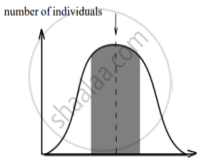Advertisements
Advertisements
Question
According to the Hardy-Weinberg principle, the allele frequency of a population remains constant. How do you interpret the change of frequency of alleles in a population?
Solution
If the Hardy-Weinberg equilibrium/genetic equilibrium is disturbed it would result in evolution. In other words, change in frequency of alleles can be interpreted by evolution. Gene flow, genetic drift, mutation, etc. are some of the disturbances which may lead to change in allele frequency.
APPEARS IN
RELATED QUESTIONS
With the help of an algebraic equation, how did Hardy-Weinberg explain that in a given population the frequency of occurrence of alleles of a gene is supposed to remain the same through generations?
In a certain population, the frequency of three genotypes is as follows:
| Genotypes: | BB | Bb | bb |
| frequency: | 22% | 62% | 16% |
What is the likely frequency of B and b alleles?
State and explain any three factors affecting allele frequency in populations.
Gene flow occurs through generations. and can occur across language barriers in humans. If we have a technique of measuring specific allele frequencies in different population of the world, can we not predict human migratory patterns in pre-history and history? Do you agree or disagree? Provide explanation to your answer.
Name the law that states that the sum of allelic frequencies in a population remains constant. What are the five factors that influence these values?
The graphs below show three types of natural selection. The shaded areas marked with arrows show the individuals in the population who are not selected. The dotted vertical lines show the statistical means.
 |
 |
 |
| character Graph A |
character Graph B |
character Graph C |
- What names are given to the types of selection shown in graphs A, B and C?
- After the selection has operated for several generations in the above populations indicated as, Graph A, B and C, graphically illustrate the probable results.
Write Hardy Weinberg's equation.
State Hardy Weinberg's principle.
A population of 200 fruit flies is in Hardy Weinberg equilibrium. The frequency of the allele (a) 0.4. Calculate the following:
Frequency of the allele (A).
A population of 200 fruit flies is in Hardy Weinberg equilibrium. The frequency of the allele (a) 0.4. Calculate the following:
The number of homozygous recessive fruit flies.
